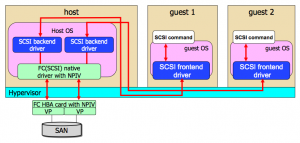One of the new features in Xen 3.3, released this week, caught my eye: Paravirtualized SCSI (PVSCSI), which allows a guest OS to directly interact with a SCSI (or Fibre Channel) HBA. This should allow more specialized applications to be virtualized in Xen environments that use SCSI or FC storage without requiring the addition of a dedicated physical storage port per guest.

Functionally similar to VMware’s Physical Compatibility Mode for Raw Device Mode (RDM) volumes, PVSCSI enables certain applications that require direct SCSI communication to function in a virtual environment. Examples include Oracle RMAN, backup applications, and potentially SAN management software.
PVSCSI plays nicely with N_Port ID Virtualization (NPIV), too, so you don’t need to assign a physical HBA port to each guest – they can all share a port or two, and each would have his own N_Port on the Fibre Channel fabric.
In their Xensummit presentation about PVSCSI, Fujitsu showed impressive performance numbers, demonstrating that the technology doesn’t cause much of a performance hit even though it is substantially more complicated than the alternative approaches. I do wonder how PVSCSI managed to outperform Dom0 with 128k writes, but let’s chalk that up to insignificant variations in timing…
Now if only Xen would update the (3.2-era) readme files on their download page!
Leave a Reply